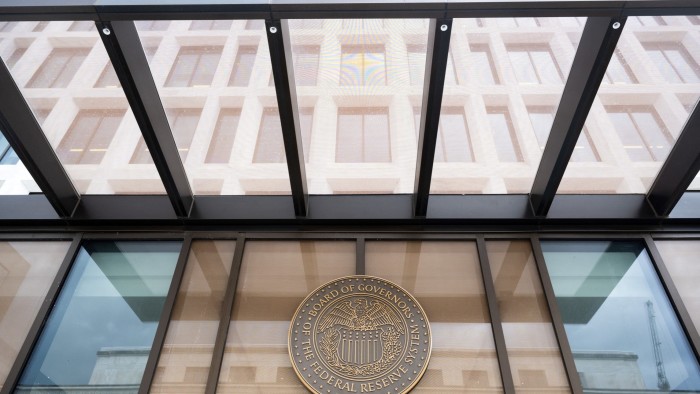Unlock the White House Watch newsletter for free
Your guide to what Trump’s second term means for Washington, business and the world
The Federal Reserve warned of rising economic risks when it kept interest rates on hold in early May, and minutes from that meeting — due to be published next week — will be poured over by investors for further signs of concern.
Chair Jay Powell used his speech in the first week of May to highlight rising “uncertainty” surrounding the trajectory of the world’s biggest economy, with markets having swung sharply on President Donald Trump’s trade tariff announcements.
Markets are currently pricing in close to two interest rate cuts by the end of this year. But some strategists think that is overly optimistic, at a time when investors are also betting that inflation one year from now will be roughly 3.4 per cent, according to the one-year US inflation swap.
While the minutes may give investors a sense of how the Federal Open Market Committee views the potential economic hit from Trump’s trade war, the president’s policies have changed drastically since the central bank last met. Washington agreed with China to slash tariffs two weeks ago but on Friday warned of plans to slap a 50 per cent tariff on imports from the EU.
“The May FOMC minutes should underscore the notion that the Fed is frozen in place until there is greater clarity on policy,” said Bank of America strategists.
“Any details on how the Fed would respond to stagflation, if it were to materialise, would be of interest to markets. But we doubt the Fed would want to lose optionality by being explicit on its reaction function at this stage,” BofA added.
Inflation data for April, also due next week, will similarly be closely watched. ING strategists expect the core Personal Consumption Expenditures index, the Fed’s preferred inflation gauge, to rise 0.1 per cent month on month. George Steer
Is the trade war back on?
Tariff concerns seemed to have taken a back seat for financial markets by this week, overtaken by headlines about US government spending and tax policies.
Then on Friday, Trump lashed out at the EU, threatening a 50 per cent tariff on the bloc. European and US stocks fell, and safe assets such as gold and sovereign debt rallied.
Until then, markets seemed to have dismissed the prospect of a full-blown, economically harmful trade war: Wall Street stocks had rallied to levels well above their levels before Trump’s “liberation day” tariff blitz. Friday’s news could put the prospect back on the table, leaving investors considering the possibility of a major disruption of global trade.
“The market forgot about the tariffs too quickly,” said Emmanuel Cau, head of European equities strategy at Barclays. “There was a lot of focus on the deficit, but the broad macro picture is still contingent on this trade war. We are not done with it.”
Some analysts rejected the notion that the trade war was back on, suggesting that Trump would capitulate as he did with China.
“This looks similar to Trump’s ‘escalate to de-escalate’ strategy for China,” said Jordan Rochester, head of macro strategy for Emea at Mizuho International. “Will it lead to a climbdown in a few weeks time? The China example suggests ‘yes’.”
However, Cau pointed out that “this is going to be a very complex negotiation” because of the multi-layered nature of the EU bloc, and warned investors against “being tempted to buy the dip”. Emily Herbert
Will bitcoin’s rally continue?
Bitcoin’s small but vocal army of bullish supporters have had plenty to cheer in recent weeks. The cryptocurrency hit record levels this week, extending a rally that began days after Trump unveiled his aggressive tariff policy in April.
The token’s 43 per cent rise since April 8 has outstripped the 10 per cent gain for gold and 24 per cent rise for the Nasdaq Composite in the same period.
Inflows into US exchange traded funds have hit $5.4bn this month, on track for the best month since January, according to data from SoSoValue. It was “a powerful signal of deepening institutional engagement”, said Hina Sattar Joshi, director of digital assets at TP ICAP.
Bitcoin enthusiasts say the drivers of the rally remain intact. Executives and traders point to a fresh wave of companies buying bitcoin to hold in their corporate treasuries. They also mention the uncertainty over US tariffs and the country’s ballooning debt reducing the attractiveness of dollar assets such as Treasuries.
Prices have also been boosted as politicians in Washington move closer to agreeing the first US rules for stablecoins, a type of digital currency that maintains the same value as the dollar.
“Combine all this with bitcoin’s inherent scarcity, and it creates a perfect storm for a comeback,” said Roshan Robert, chief executive of the US arm of OKX, the crypto exchange.
Analysts are wondering how much further bitcoin’s rally has to run.
Geoff Kendrick of Standard Chartered forecasts the cryptocurrency will rise to $120,000 by the end of June and $200,000 by the end of the year. Philip Stafford
https://www.ft.com/content/891e95d5-f702-4176-8607-03c5951ae027


